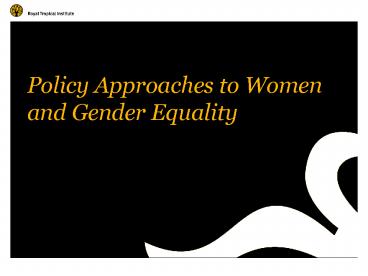Policy Approaches to Women and Gender Equality - PowerPoint PPT Presentation
1 / 14
Title:
Policy Approaches to Women and Gender Equality
Description:
Two conceptual frameworks: 'Women in Development' and 'Gender and Development' ... challenging, especially of gender division of labour, and still widely popular. ... – PowerPoint PPT presentation
Number of Views:556
Avg rating:3.0/5.0
Title: Policy Approaches to Women and Gender Equality
1
Policy Approaches to Women and Gender Equality
2
Approaches to Women and Gender Equality
- Two conceptual frameworks Women in Development
and Gender and Development - Different policy approaches welfare, equity,
anti-poverty, efficiency, empowerment and gender
mainstreaming
3
(No Transcript)
4
(No Transcript)
5
(No Transcript)
6
(No Transcript)
7
Approaches to Women and Gender Equality
- Different policy approaches
- welfare,
- equity,
- anti-poverty,
- efficiency,
- empowerment
- gender mainstreaming
8
Welfare approach
- earliest approach, predominant 1950-1970.
- aim is to bring women into the development as
better mothers. - women are seen as the passive beneficiaries of
development emphasizing their reproductive role - seeks to meet practical gender needs in that role
through a top-down handouts of food aid, measures
against malnutrition and family planning - not challenging, especially of gender division of
labour, and still widely popular.
Source March, C., Smyth, I., and Mukhopahhyay,
M. (1999). A Guide to Gender Analysis Frameworks.
Oxfam Oxford
9
Equity approach
- original WID approach, emerged during in the
76-85 UN Womens Decade, within the predominant
growth with equity development approach - aim is to gain equity for women who are seen as
active participants in development - recognizes womens triple role (productive,
reproductive and community), and seeks to meet
strategic gender interests by direct state
intervention giving political and economic
autonomy and reducing inequality with men. - challenges womens subordinate position
- criticised as western feminism, is considered
threatening to men and is unpopular with
governments and donors.
10
Anti- Poverty approach
- 2nd WID approach, a toned-down version of equity,
from 1970s onwards in the context of Basic Needs
approaches to development - women seen as disproportionately represented
among poor - aim is to ensure that poor women increase their
productivity - womens poverty is seen as a problem of
underdevelopment, not of subordination - recognizes the productive role of women, and
seeks to meet their practical to earn an income,
particularly in small scale income generation
projects - still most popular with NGOs
11
Efficiency approach
- 3rd WID approach, adopted since the 1980s debt
crisis. - aims to ensure that development is more efficient
and effective through womens economic
contribution, with participation often equated
with equity and decision making - seeks to meet practical gender needs while
relying in all three roles and an elastic concept
of womens time - women seen in terms of their capacity to
compensate for declining social services by
extending their working day
12
Empowerment
- articulated by third-world women with aim to
empower women through greater self-reliance - explicitly acknowledges centrality of power and
womens need for more power to improve position - womens subordination is expressed in terms of
male oppression and colonial and neo-colonial
oppression - recognizes the triple role seeks to meet
strategic gender interests indirectly thru
grassroots mobilization of practical gender needs - potentially challenging, but its avoidance of
western feminism makes it unpopular except with
third world womens NGOs.
13
Gender mainstreaming
- associated with the 1995 World Conference on
Women in Beijing and the Beijing Platform of
Action that signaled the UNs first official use
of the term - call for gender mainstreaming was a culmination
of two inter-related changes in discourse prior
to Beijing - Women in Development to gender and development
- integrating women to mainstreaming gender
14
Gender mainstreaming
- Women in Development to gender and development
- some improvements in womens material conditions,
but little progress in their status - the nature of womens relational subordination
was ignored and unequal gender power relations
remained unaltered - integrating women vs. mainstreaming gender
- relates to the second problem associated with
WID, the continued marginalization of women and
womens issues from mainstream development - mainly due to how WID was implemented the
establishment of womens national machineries and
WID units and the emphasis on womens projects - mainstreaming was seen as a way of promoting
gender equity in all of the organizations
pursuits































